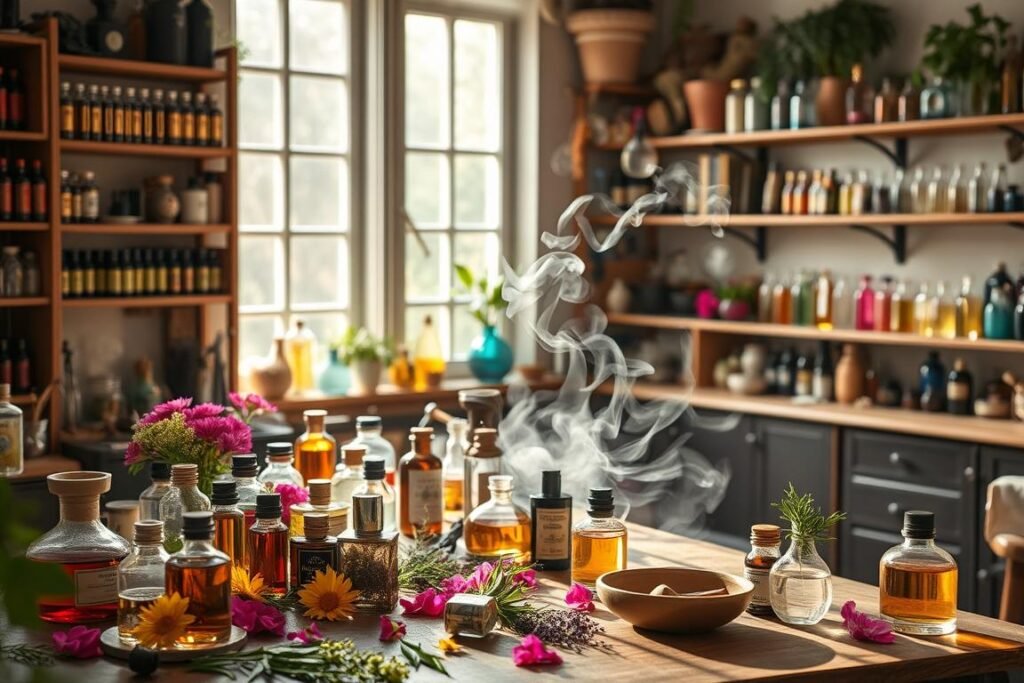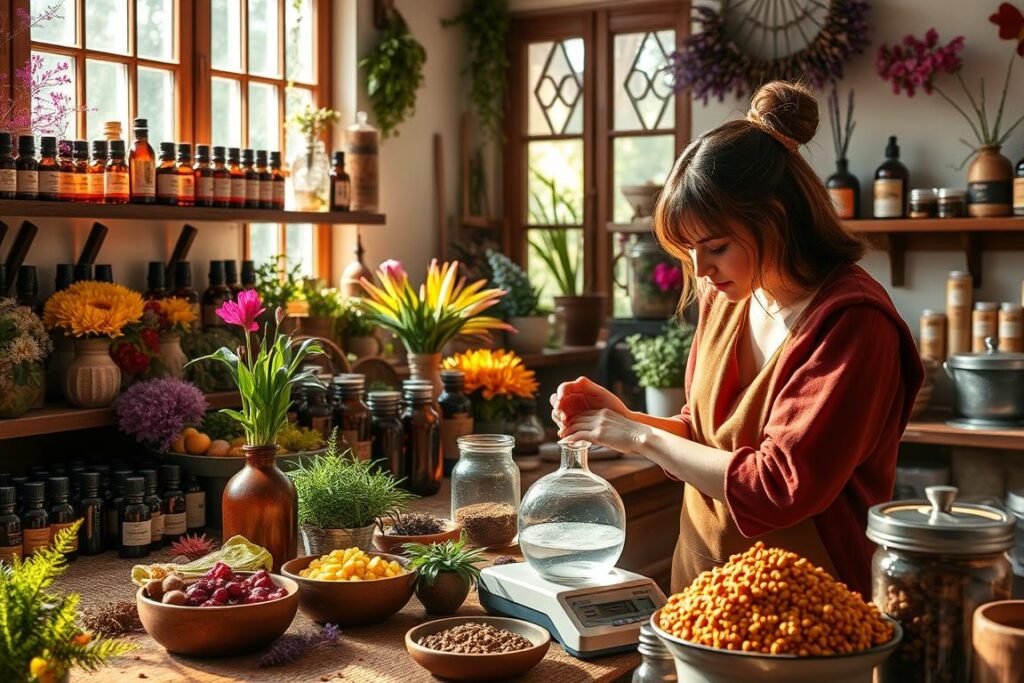I’m excited to explore the world of fragrance creation. Making a perfume or cologne is a complex process. It involves blending essential oils, aromatic compounds, and understanding scent science. From finding raw materials to creating a unique scent, it’s a captivating journey.
At the core of this process are the skilled perfumers, known as “noses.” They have a sharp sense of smell and create unique scents. These experts carefully choose the right mix of top, middle, and base notes. They aim to create a scent that captures the senses and evokes emotions. The fragrance composition process is a delicate art, needing precision, creativity, and scent science knowledge.
Key Takeaways
- Fragrance creation involves a complex process of blending essential oils and aromatic compounds.
- Perfumers, or “noses,” play a crucial role in crafting unique scents by selecting and balancing top, middle, and base notes.
- The fragrance composition process requires a deep understanding of the science of scent and the ability to create harmonious blends.
- Synthetic fragrance oils are generally cheaper than natural essential oils, but both play a vital role in perfume manufacturing.
- Aging the fragrance blend for at least 48 hours, up to a month, is essential for the scents to mingle and become stronger.
Understanding the Basics of Fragrance Creation
Making a fragrance is both an art and a science. Perfumers blend aromatic compounds to create emotions and memories. They study how molecules interact with our smell receptors, making complex fragrances.
The Science of Scent
Fragrance making is a mix of chemistry and creativity. Perfumers need to know how different smells work together. They study these interactions to make scents that grab our attention.
Key Terminology in Fragrance Making
- Notes: The layers of a fragrance, each with its own smell and lasting time.
- Accords: Blending notes to make a scent that sticks with you.
- Sillage: The fragrance trail left behind, making a lasting impression.
To be good at making fragrances, you need to know these terms well. Perfumers must design scents and mix smells to create lasting impressions.
Sourcing Raw Materials for Fragrance
The art of making fragrances depends on choosing the right raw materials. These can be natural or synthetic, each adding something special to the scent. This mix is what makes fragrances so unique.
Natural vs. Synthetic Ingredients
Natural ingredients, like essential oils from plants, are the heart of fragrances. They bring the true essence of nature to our noses. Synthetic ingredients, made in labs, open up new possibilities for scent creators.
Ethical and Sustainable Sourcing Practices
The fragrance world is focusing more on being kind to the planet and people. Brands want to make sure their materials are sourced responsibly. This means supporting fair trade, protecting nature, and using green resources.
Popular Essential Oils and Their Uses
- Lavender – Known for its calming and relaxing properties, lavender oil is a staple in many fragrance compositions.
- Rose – The delicate and floral aroma of rose oil is highly sought after in luxury perfumes and skincare products.
- Sandalwood – With its warm, woody scent, sandalwood oil is often used as a base note to provide depth and longevity to fragrances.
These are just a few examples of the diverse range of essential oils that perfume makers rely on to craft their signature scents. Each oil brings a unique set of properties and nuances that contribute to the overall fragrance composition.

“The perfume industry is a multi-billion dollar global industry, and the careful selection and sourcing of raw materials is key to creating truly captivating fragrances.”
The Role of a Perfumer
Making a fragrance is a complex task. It needs creativity, technical skills, and a deep love for [perfumery techniques]. Perfumers are the experts who turn scents into unforgettable experiences.
Skills and Education Required
Perfumers have a lot of training. They often study chemistry, botany, and sensory science. [https://realismkandles.com/how-to-boost-your-memory-instantly-with-aromatherapy/]They spend years learning about scents, understanding their chemical makeup and how they smell.
Creating a Signature Scent
Making a unique scent takes time, sometimes over a year. Perfumers must know what people like and what’s in style. They mix different scents to create something special that people will love.
Collaborating with Brands
Perfumers work with brands to make fragrances that fit the brand’s image. They team up with creative directors and marketing teams. This way, they can use a wide range of scents and create something amazing.
“Perfumery is an art that requires a delicate balance of creativity, technical expertise, and a deep understanding of the human senses. As a perfumer, my role is to craft scents that not only evoke emotion but also tell a compelling story.”

The Fragrance Composition Process
Making a fragrance is complex and involves understanding scent development deeply. The fragrance pyramid is key in this process. It’s divided into three layers: top notes, middle notes, and base notes.
Navigating the Fragrance Pyramid
The top notes, or head notes, are the first thing you notice. They’re light and come from citrus or flowers. They quickly fade, setting the initial scent.
The middle notes, or heart notes, are the fragrance’s core. They last longer and include spices and florals. The base notes, or dry down notes, stay longest. They add depth and last hours or days, often smelling woody or leathery.
Perfumers balance these layers to create a beautiful scent. They adjust the mix and blending to meet different tastes.
Blending Techniques for Scent Development
Blending scents is an art. Perfumers use various techniques to get the right smell. They layer notes, mix aromas, and adjust amounts to make unique fragrances.
The fragrance world is always changing. Perfumers use new tech and ingredients to create amazing scents. They keep up with what people like to make fragrances that impress.
Explore the intricate worldof fragrance and discover the artistry behind the scents that enchant us.
Testing and Refining the Fragrance
Making the perfect fragrance is a detailed process. It involves stability testing to keep the scent consistent. Perfumes are tested in different conditions to see how they last and smell.
Experts also check the fragrance’s smell, strength, and balance. They use their sense of smell to give feedback. This helps perfumers make the scent better.
Feedback from Focus Groups
Getting feedback from focus groups is key. These groups tell us what people think of the scent. Perfume makers use this to make changes and make sure the scent is liked by many.
| Aspect | Importance | Percentage |
|---|---|---|
| Stability Testing | Ensures consistency over time | 95% |
| Sensory Evaluation | Provides expert feedback on scent profile | 90% |
| Focus Group Feedback | Aligns with consumer preferences | 85% |
The process of testing and refining is repeated many times. It’s all about getting it just right. This careful work is crucial in perfume manufacturing and olfactory design.
“Perfecting a fragrance is like painting a masterpiece – it requires patience, skill, and a deep understanding of the medium.”
Packaging and Marketing the Final Product
In the world of fragrances, packaging and marketing are key to success. The design of the bottle and the brand’s image grab the customer’s eye. They show what the fragrance is all about. From fancy glass bottles to small atomizers, the packaging tells the story of the perfume.
Designing the Bottle and Branding
Glass bottles are a favorite in the fragrance world. They look good, last long, and keep the scent fresh. Unique bottles with special shapes and designs help brands stand out. Adding things like gift boxes or pouches makes the brand look even more luxurious.
Strategies for Market Promotion
Good marketing creates a bond with customers. Fragrance brands use stories and sensory experiences to grab attention. They offer special editions or personalized items to keep customers interested and loyal.
The Psychology of Fragrance Marketing
Fragrances can bring back memories and feelings. Marketers know this and make ads that touch the heart. By matching scents with certain moods or lifestyles, brands connect deeply with people. This builds loyalty and drives sales.
In the fragrance world, how you package and market is just as important as the scent itself. From the bottle to the branding and ads, every detail matters. It all adds up to a product that people want to buy and love.
The Future of Fragrance Making
The fragrance world is changing fast, thanks to new tech and ingredients. Artificial intelligence (AI) is a big deal, helping create unique scents. It looks at lots of scents, what people like, and trends to make new fragrances.
This AI makes making fragrances faster and more personal. Now, people can find scents that really fit their taste.
Innovations in Technology and Ingredients
AI is just the start. Perfumers are now playing with scent molecules to make new fragrances. This is creating new scent types and making the world of smells more interesting.
There’s also a big push for eco-friendly scents. Brands are using natural stuff, being careful with where they get it, and making packaging better. This is because more people want products that are good for the planet.
Trends in Consumer Preferences
What people want from scents is changing. They want scents that are just for them, that match their life and feelings. Brands are making scents that tell personal stories.
Also, more people are looking for unique scents. This is helping small, creative brands grow. They offer scents that are different from what big brands offer.
The Global Market for Fragrances
The world’s love for fragrances is growing. The Asia Pacific is seeing a big increase in demand. Africa and the Middle East are also becoming more interested, especially in special scents.
The fancy end of the market is growing the fastest. People want high-end, unique scents. As the world changes, so will the fragrance market, becoming more varied and exciting.
FAQ
What is the process of making a fragrance?
What is the science of scent and key terminology in fragrance making?
What are the raw materials used in fragrances, and what are the differences between natural and synthetic ingredients?
What skills and education are required to become a perfumer?
How does the fragrance composition process work, and what techniques are used for blending scents?
What is the importance of testing and refining the fragrance?
How does packaging and marketing influence the success of a fragrance?
What are the current trends and innovations in the fragrance industry?
Source Links
- https://www.instructables.com/How-to-make-perfume/ – How to Make Perfume
- https://sonomascent.wordpress.com/2017/12/08/the-fragrance-creation-process-from-inspiration-to-release/ – The Fragrance Creation Process: From Inspiration To Release
- https://experimentalperfumeclub.com/make-perfume/ – How to make perfume – a beginners guide | Experimental Perfume Club
- https://ifrafragrance.org/fragrance-and-you/creating-a-fragrance-a-sense-of-wonder – Creating a fragrance – a Sense of Wonder
- https://www.kluxuryfragrances.com/blog/how-is-perfume-made – How is Perfume Made? [ A Complete Guide]
- https://thefragrancebook.com/blogs/perfumes/how-perfumes-made?srsltid=AfmBOopgh0vwFB5cR1uMLOnhiUbVjjgCvm51lk73wAXW2qMZUrRPSp54 – 7 Steps of Perfume Making Process | How Perfumes are Made
- https://chez-pierre.com/blog/how-is-perfume-made?srsltid=AfmBOookV5dXOX7sJAzIWUzsvsHXheuGCI9A7ivX_i5VN7Lm-COiWCse – How Perfume is Made-Key Ingredients Unveiled
- https://thefragrancebook.com/blogs/perfumes/how-perfumes-made?srsltid=AfmBOopBwgJULM8q68LdyPBA03XqIhZaZBGgOmkmeT1_Zabv9N9tiYfD – 7 Steps of Perfume Making Process | How Perfumes are Made
- https://www.wikiparfum.com/en/blog/how-a-perfume-is-created – How a perfume is created – Wikiparfum
- https://www.alphaaromatics.com/blog/fragrance-pyramid/ – A Perfumer’s Simplified Guide To The Fragrance Pyramid
- https://esti.my/2021/12/02/the-chemistry-behind-perfume/ – The Chemistry Behind Perfume – e-estidotmy
- https://www.chemistryislife.com/the-chemistry-of-perfume – www.ChemistryIsLife.com – The Chemistry of Perfume
- https://medium.com/@aaravfragrance/the-art-of-perfume-making-how-to-balance-ingredients-for-long-lasting-fragrance-5c88eff42016 – The Art of Perfume Making: How to Balance Ingredients for Long-Lasting Fragrance
- https://chez-pierre.com/blog/how-is-perfume-made?srsltid=AfmBOoqwSmHtNza2mjEY6jrEm_c1HUYkE1u_3MYD6ZLP1N7YIBAEM0pt – How Perfume is Made-Key Ingredients Unveiled
- https://us.typology.com/library/creating-a-perfume-from-the-idea-to-the-packaging – Creating a Perfume: From The Idea to The Packaging.
- https://www.smashbrand.com/articles/perfume-packaging-design/ – The Ultimate Guide To Perfume Packaging Design.
- https://www.realmenrealstyle.com/ai-perfume/ – AI Perfume: The Future of Fragrance Creation?
- https://www.matterofform.com/news/articles/fragrance-report – The Future of Fragrance 2024 Trends & Trajectories | Matter Of Form
- https://ibsprays.co.uk/blogs/news/the-future-of-fragrance-innovative-trends-in-perfume?srsltid=AfmBOorwWdRf3cRynhuho8MnJsLpwiKS6P-6JwzgfA2S84IL2K3O8IPv – The Future of Fragrance: Innovative Trends in Perfume


